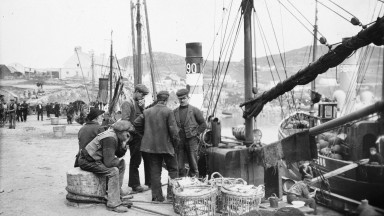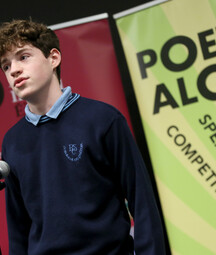The exhibition captures the social, cultural and technological changes that have taken place across Ireland from the middle of the 19th century up to the turn of this century, and has a number of photos charting Donegal life.
The exhibition offers unique glimpses into Irish history and ordinary Irish lives, as well the evolution of photography, including a snapshot of women in the 1860s selling refreshments in Killarney and a remarkable shot of a passing steam train in Clones, Co Monaghan in 1959.
The exhibition comprises 50 photographs taken between 1858 – 2001, representing the age of analogue photography in Ireland. Photographs on display include early forms such as salt paper print and stereo-pair up to more contemporary photography.
One striking image in the exhibition, which is a glass negative in black and white, and is 6.2 x 8.8 cm, features a young man in a field with horse-drawn plough, with an older woman in the background watching on. This is part of the Tynan Photographic Collection at the NLI.
A second photograph is of a nurse visiting a family on Arranmore Island, County Donegal, around 1906 – 1914. Public health was a recognised issue in the poor, over-populated and underdeveloped areas of Ireland at the time, designated as congested districts. In 1903, Lady Dudley, wife of the Viceroy to Ireland, established the Dudley Nursing Scheme to train women to be public health nurses. This image is part of the Congested Districts Board Photograph Collection, and is a photographic print, 8 x 14 cm.
A third photograph is of Fishermen on Downings Pier, County Donegal, around 1909-10. The Congested District Board provided funding to build safer and bigger piers and harbours to encourage the fishing industry in Donegal, Galway and Mayo. The construction of a pier extension in Downings began in 1910. The collected photograph is 8 x 14 cm.
A fourth Donegal-based photograph captures a go-kart race taking place in Glenties, Donegal around 1950-1960, taken from the Tynan Photographic Collection. This was collected as a glass negative in black and white and is 6.2 x 8.8 cm.
Commenting, Acting Head of Exhibitions, Learning and Programming at the NLI and curator of this exhibition, Sara Smyth said:
“What’s collected today becomes history tomorrow. As Ireland’s memory-keeper, the NLI continues to collect and share a vibrant national collection that documents historical and contemporary life on the island of Ireland. The NLI houses over five million photographs, which are a visual record of the history and culture of Ireland.
“The exhibition will run until 2025 and phase one will feature framed photographs from 20 of our most popular collections. The images selected speak to the diversity of Ireland, with photographs representing almost every county, North and South of the Border.
“We highlight working-class and middle-class communities; women, who usually appear less often than men in history telling; and we juxtaposition rural communities alongside their urban counterparts. Themes, such as climate change and transport, are also addressed.”
Join the exhibition’s curator, Sara Smyth, for a free tour of the exhibition over the Summer, with the next monthly tour on Thursday 17th August from 1.00-1.40pm, no booking required.
If you are in Dublin with friends, young kids or family, you can pop into the free and accessible People and Places exhibition 10am–4pm Monday to Sunday, with last admission 3.30pm.
To check out more photographs which are part of NLI’s collections, log onto www.nli.ie.
ENDS

![Letter from Neal McMonagle, Morris Island [South Carolina], to his brother Cornelius McMonagle](/sites/default/files/styles/card_small/public/2025-12/vtls000941976_001_0.jpg?h=a55a8d34&itok=UrkTjFUa)
